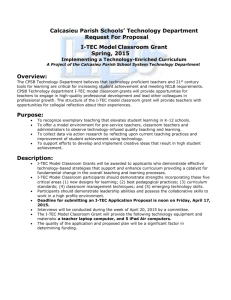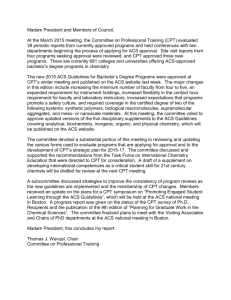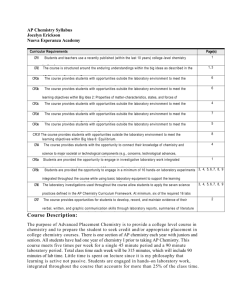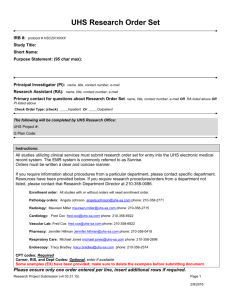Syllabus
advertisement
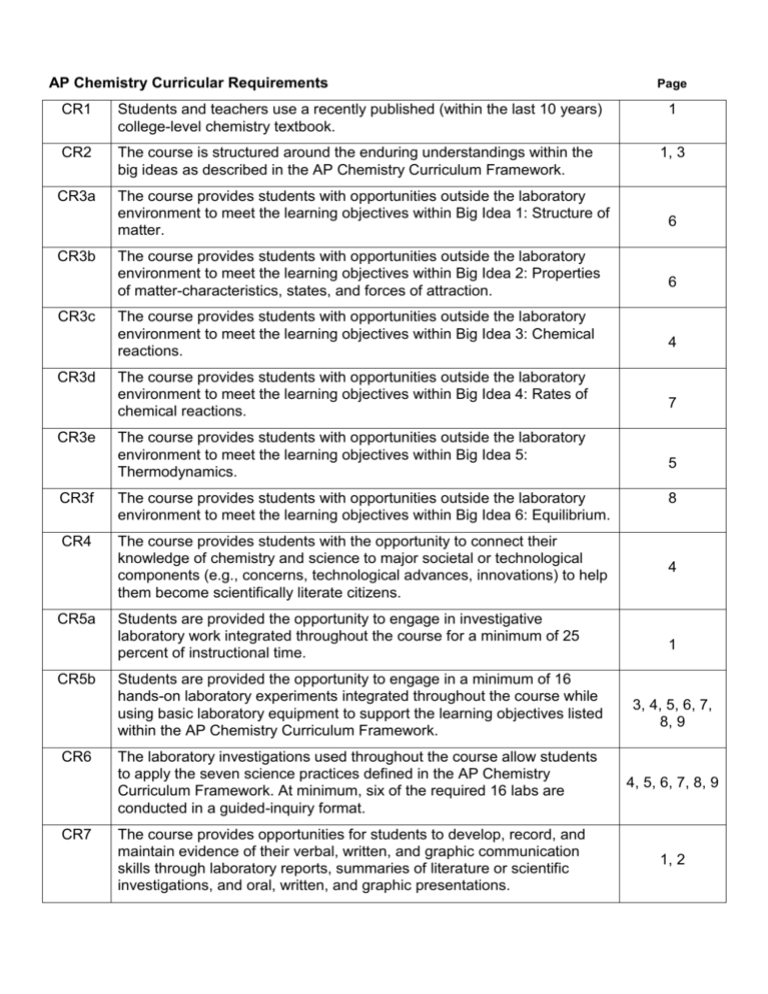
AP Chemistry Curricular Requirements CR1 Students and teachers use a recently published (within the last 10 years) college-level chemistry textbook. CR2 The course is structured around the enduring understandings within the big ideas as described in the AP Chemistry Curriculum Framework. CR3a The course provides students with opportunities outside the laboratory environment to meet the learning objectives within Big Idea 1: Structure of matter. CR3b CR3c CR3d CR3e The course provides students with opportunities outside the laboratory environment to meet the learning objectives within Big Idea 2: Properties of matter-characteristics, states, and forces of attraction. The course provides students with opportunities outside the laboratory environment to meet the learning objectives within Big Idea 3: Chemical reactions. The course provides students with opportunities outside the laboratory environment to meet the learning objectives within Big Idea 4: Rates of chemical reactions. The course provides students with opportunities outside the laboratory environment to meet the learning objectives within Big Idea 5: Thermodynamics. CR3f The course provides students with opportunities outside the laboratory environment to meet the learning objectives within Big Idea 6: Equilibrium. CR4 The course provides students with the opportunity to connect their knowledge of chemistry and science to major societal or technological components (e.g., concerns, technological advances, innovations) to help them become scientifically literate citizens. CR5a CR5b CR6 CR7 Students are provided the opportunity to engage in investigative laboratory work integrated throughout the course for a minimum of 25 percent of instructional time. Students are provided the opportunity to engage in a minimum of 16 hands-on laboratory experiments integrated throughout the course while using basic laboratory equipment to support the learning objectives listed within the AP Chemistry Curriculum Framework. The laboratory investigations used throughout the course allow students to apply the seven science practices defined in the AP Chemistry Curriculum Framework. At minimum, six of the required 16 labs are conducted in a guided-inquiry format. The course provides opportunities for students to develop, record, and maintain evidence of their verbal, written, and graphic communication skills through laboratory reports, summaries of literature or scientific investigations, and oral, written, and graphic presentations. Page 1 1, 3 6 6 4 7 5 8 4 1 3, 4, 5, 6, 7, 8, 9 4, 5, 6, 7, 8, 9 1, 2 Page 1 Course Description: CR5a—Students are The purpose of Advanced Placement Chemistry is to provide a college level course in chemistry and to prepare the student to seek credit and/or appropriate placement in college chemistry courses. This course meets every other day for 80 minutes and 40 minutes in seminar. Little time is spent on lecture since it is my philosophy that learning is active not passive. Students are engaged in hands-on laboratory work, integrated throughout the course that accounts for more than 25% of the class time. [CR5a] Emphasis is placed on depth of understanding of a topic, rather than breadth of topics. Study groups will be organized and old AP Chemistry Free Response questions/Study Guides are used for review. provided the opportunity to engage in investigative laboratory work integrated throughout the course for a minimum of 25% of instructional time. Objectives: Students will: 1. Learn the inquiry process through numerous laboratory investigations. 2. Gain an understanding of the six big ideas as articulated in the AP Chemistry Curriculum Framework. [CR2] 3. Apply mathematical and scientific knowledge and skills to solve quantitative, qualitative, spatial, and analytic problems. CR2—The course is 4. Apply basic arithmetic, algebraic, and geometric concepts. 5. Formulate strategies for the development and testing of hypotheses. 6. Use basic statistical concepts to draw both inferences and conclusions from data. 7. Identify implications and consequences of drawn conclusions. 8. Use manipulative and technological tools including the Texas Instruments Nspire CAS CX Handhelds, Vernier LabQuests, Vernier Probes, and Vernier’s LoggerPro software. 9. Measure, compare, order, scale, locate, and code accurately. structured around the enduring understandings within the big ideas as described in the AP Chemistry Curriculum Framework. 10. Do scientific research and report and display the results of this research. 11. Learn to think critically in order to solve problems. Textbook, Laboratory Manual, Solutions Manual and Study Guides: CR1—Students and teachers Zumdahl, Steven S., et. al., Chemistry, 8th Edition. Boston, New York, use a recently published Houghton Mifflin Company, 2010. [CR1] (within the last 10 years) Laboratory Work: All of the laboratory experiments in this course are hands-on. Students work individually or in a group of two depending upon the lab. They collect, process, manipulate, and graph data from both qualitative and quantitative observations. Inquiry is emphasized in many of the experiments that students complete. The laboratory work requires students to design, carry out, and analyze data using guided inquiry principles. For all labs, students are required to report the purpose, procedure, all data, data analysis, error analysis, results, and conclusions in a lab report that is submitted for grading. [CR7] All laboratory experiments are intended to be completed in 1-2 class periods (or in seminar). Enough time will be allotted for the following guided-inquiry labs: 1. Determination of the Formula of a Compound 2. Finding the Ratio of Moles of Reactants in a Chemical Reaction college-level chemistry textbook. CR7 - The course provides opportunities for students to develop, record, and maintain evidence of their verbal, written, and graphic communication skills through laboratory reports, summaries of literature or scientific investigations, and oral, written, and graphic presentations. Page 2 3. Progressive Precipitation 4. Hess’s Law 5. Relationship Between the Spectrum and Absorbance of Light 6. Conductivity of Solids & Metals 7. Factors that affect reaction rates and determining reaction rates and reaction mechanisms 8. Equilibrium Position 9. Hydrolysis of Salts CR7 - The course provides opportunities for students to develop, record, and maintain evidence of their verbal, written, and graphic communication skills through laboratory reports, summaries of literature or scientific investigations, and oral, written, and graphic presentations. 10. Electrochemical Cells Technology: Students use Texas Instruments NSpire CAS CX Handhelds in both their class work and laboratory work. Students use Vernier LabPros and probes in laboratory work to gather data. Graphs are produced using Vernier LoggerPro software. Laboratory Notebook: A laboratory notebook is required for the course. All completed lab reports documenting all lab experiences must be included in the notebook. The notebook is checked periodically with a final check at the end of the course. [CR7] Tests: A chapter test is assigned for each chapter. A comprehensive, standardized semester exam is administered at the end of 1st semester and a final exam at the end of the year. AP Exam Review: The final 2 weeks of full class days before the AP Chemistry Exam are used for exam review and practice tests using old AP Chemistry exam materials. Students work in cooperative groups to solve a packet of free response problems from previous exams. Students practice net ionic equations and are quizzed on their progress. Several practice AP Exams are administered as part of the two-week review prior to the AP Chemistry Exam. Page 3 Course Outline: [CR2] Chapters in Zumdahl Chemistry 1. Chemical Foundations 2. Atoms, Molecules, and Ions 3. Stoichiometry 4. Solution Stoichiometry & Chemical Analysis 5. Gases 6. Thermochemistry 7. Atomic Structure and Periodicity 8. Bonding -- General Concepts 9. Covalent Bonding: Orbitals 10. Liquids and Solids 11. Properties of Solutions 12. Chemical Kinetics 13. Chemical Equilibrium 14. Acids and Bases 15. Applications of Aqueous Equilibria 16. Spontaneity, Entropy, and Free Energy 17. Electrochemistry 18. The Nucleus -- A Chemist’s View 19. The Representative Elements: Groups 1A Through 4A 20. The Representative Elements: Groups 5A Through 8A 22. Organic Chemistry AP Chemistry Exam Review AP Chemistry Topic Covered None Atomic Theory & Atomic Structure (BI 1 & 2) Stoichiometry (BI 3) Reaction Types & Stoichiometry (BI 3) Gases (BI 1 & 2) Thermodynamics (BI 5) Atomic Theory & Atomic Structure (BI 1 & 2) Chemical Bonding (BI 1 & 2) Chemical Bonding (BI 1 & 2) Liquids & Solids (BI 1 & 2) Solutions (BI 2) Kinetics (BI 4) Equilibrium (BI 6) Equilibrium (BI 6) Equilibrium (BI 6) Thermodynamics (BI 5) CR2-The course is structured around the enduring understandings within the big ideas as described in the AP Chemistry Curriculum Framework. Reaction Types (BI 3) Nuclear Chemistry Descriptive Chemistry (BI 2) Descriptive Chemistry (BI 2) Descriptive Chemistry All (BI) refers to Big Ideas. Big Idea 1 – Structure of matter, Big Idea 2 – Properties of mattercharacteristics, states and forces of attraction, Big Idea 3 – Chemical reactions, Big Idea 4 – Rates of chemical reactions, Big Idea 5 – Thermodynamics, Big Idea 6 – Equilibrium. NOTE: In assignments, the terms Learning Objectives (LO) and Science Practices (SP) are used. Assignments: Chapter 1: Chemical Foundations Read: Pages 1-30 Problems: Recommended Problems in textbook CR5b-Students are provided the opportunity to engage in a minimum of 16 hands-on laboratory experiments integrated throughout the course while using basic laboratory equipment to support the learning objectives listed within the AP Chemistry Curriculum Framework. Page 4 Labs: Safety/Lab Skills/Lab Preparation Chromatography (SP 6.1; LO 2.18) [CR5b] & [CR6] Fractional Distillation (SP 4.2, 5.1, 6.4; LO 2.10) CR6-The laboratory investigations used throughout the course allow students to apply the seven science practices defined in the AP Chemistry Curriculum Framework. At minimum, six of the required 16 labs are conducted in a guided-inquiry format. [CR5b] & [CR6] Activity: Based on the Kool Aid Chromatography lab, students write an analysis on the GRAS (generally regarded as safe) requirements, the use of, the chemical structure of, and problems associated with certain food dyes. [CR4] Chapter 2: Atoms, Molecules, and Ions Read: Pages 39-68 Problems: Recommended Problems in textbook Labs: Determination of Avogadro’s Number (SP 2.2, 6.1; LO 3.6) [CR5b] & [CR6] CR4-The course provides students with the opportunity to connect their knowledge of chemistry and science to major societal or technological components (e.g., concerns, technological advances, innovations) to help them become scientifically literate citizens. CR5b-Students are provided the opportunity to engage in a minimum of 16 hands-on laboratory experiments integrated throughout the course while using basic laboratory equipment to support the learning objectives listed within the AP Chemistry Curriculum Framework. Chapter 3: Stoichiometry Read: Pages 76-116 Problems: Recommended Problems in textbook Labs: Determination of the Formula of a Compound (SP 4.2, 5.1, 6.4; LO 3.5) [CR5b] & [CR6] Finding the Ratio of Moles of Reactants in a Chemical Reaction (SP 2.1, 2.2, 4.2, 5.1, 6.4; LO 3.3, 3.5) [CR5b] & [CR6] Chemical Reactions of Copper and Percent Yield (SP 1.4, 2.1, 2.2, 4.2, 5.1, 6.1, 6.4; LO 1.19, 3.2, 3.3, 3.4, 3.10) Activity:(LO 3.6): Use data from synthesis or decomposition of a compound to confirm the conservation of matter and the law of definite proportions. CR3c-The course provides students with opportunities outside the laboratory environment to meet the learning objectives within Big Idea 3: Chemical reactions. The students present problems to the class in which they demonstrate how to find the empirical formula of a compound from data on the percent composition by mass. [CR3c] Page 5 Chapter 4: Types of Chemical Reactions and Solution Stoichiometry Read: Pages 129-170 CR5b-Students are provided the Problems: opportunity to engage in a minimum of Recommended Problems in textbook 16 hands-on laboratory experiments integrated throughout the course while Labs: using basic laboratory equipment to Use of a Primary Standard -- KHC8H4O4 [CR5b] & [CR6] support the learning objectives listed Reduction of Permanganate within the AP Chemistry Curriculum (SP 4.2, 5.1, 6.4; LO 1.20, 3.3) [CR5b] & [CR6] Framework. Progressive Precipitation (SP 1.5, 2.2, 4.2, 5.1, 6.4; LO 1.19, 2.10, 3.2, 3.3) [CR5b] & [CR6] Chapter 5: Gases Read: Pages 180-222 Problems: Recommended Problems in textbook Labs: Investigating Graham’s Law (SP 2.2, 2.3; LO 2.6) [CR5b] & [CR6] Ideal Gas Law (SP 2.2, 2.3; LO 2.6) [CR5b] & [CR6] The Determination of the Molar Mass of a Volatile Liquid (SP 1.3, 1.4, 6.4, 7.2; LO 2.4, 2.5) [CR5b] & [CR6] CR6-The laboratory investigations used throughout the course allow students to apply the seven science practices defined in the AP Chemistry Curriculum Framework. At minimum, six of the required 16 labs are conducted in a guided-inquiry format. Chapter 6: Thermochemistry Read: Pages 235-274 Problems: Recommended Problems in textbook Labs: Hess’s Law (SP 4.2, 5.1, 6.4; LO 5.6, 5.7) [CR5b] & [CR6] Heat of Combustion of Magnesium (SP 4.2, 5.1, 6.4; LO 5.6, 5.7) [CR5b] & [CR6] Activity: LO 5.2: Students relate temperature to the motions of particles, either via particulate representations, such as drawings of particles with arrows indicating velocities, and/or via representations of average kinetic energy and distribution of kinetic energies of the particles, such as plots of the Maxwell- Boltzmann distribution. [CR3e] Students are accountable for answering homework questions CR3e-The course provides about particle motions and kinetic energies of a sample at students with opportunities different temperatures while viewing a Podcast. The podcast outside the laboratory begins with particulate animations and the narrator interprets environment to meet the the animations to show how kinetic energy distributions learning objectives within Big can explain the effect of temperature on the rate of a chemical Idea 5: Thermodynamics. reaction. The questions lead to the interpretation of activation energy on the distribution curve and eventually the refining of collision theory. Page 6 Chapter 7: Atomic Structure and Periodicity Read: Pages 284-328 Problems: Recommended Problems in textbook CR5b—Students are provided the Labs: Relationship Between the Spectrum and Absorbance of Light (SP 4.1; LO 1.15) [CR5b] & [CR6] Poison in the Kool Aid-A Spectroscopic Inquiry (SP 4.1, 4.2, 5.1, 6.4; LO 1.15, 1.16) [CR5b] & [CR6] Beer’s Law (SP 4.2, 5.1; LO 3.4) [CR5b] & [CR6] Activity: LO 1.10: Justify with evidence the arrangement of the periodic table and apply periodic properties to chemical reactivity. Students are given several elements pairing them by families or by period and are asked to rationalize the change in electronegativity of each group based on the electronic structure of the atom [CR3a] Chapter 8: Bonding: General Concepts Read: Pages 339-391 Problems: Recommended Problems in textbook Lab: Molecular Geometry (SP 1.4; LO 2.21) [CR5b] & [CR6] Conductivity of Solids & Metals (SP 4.2, 6.4; LO 2.22) [CR5b] & [CR6] opportunity to engage in a minimum of 16 hands-on laboratory experiments integrated throughout the course while using basic laboratory equipment to support the learning objectives listed within the AP Chemistry Curriculum Framework. CR6—The laboratory investigations used throughout the course allow students to apply the seven science practices defined in the AP Chemistry Curriculum Framework. At minimum, six of the required 16 labs are conducted in a guidedinquiry format. CR3a—The course provides students with opportunities outside the laboratory environment to meet the learning objectives within Big Idea 1: Structure of matter. CR3b—The course provides students with opportunities outside the laboratory environment to meet the learning objectives within Big Idea 2: Properties of matter-characteristics, states, and forces of attraction. Activity: LO 2.21: Use Lewis diagrams and VSEPR to predict the geometry of molecules, identify hybridization, and make predictions about polarity. Students construct balloon models of the arrangement of pairs of electrons around a central atom. They then draw 2D pictures of these arrangements and apply these to predicting the shapes of molecules. [CR3b] Chapter 9: Covalent Bonding: Orbitals Read: Pages 403-429 Problems: Recommended Problems in textbook Lab: Determination of the Formula of a Hydrate (SP 2.1, 4.2, 6.4; LO 3.5) [CR5b] & [CR6] Page 7 Chapter 10: Liquids and Solids Read: Pages 438-485 Problems: Recommended Problems in textbook Labs: The Structure of Crystals (SP 1.1, 1.4, 7.1; LO 2.19, 2.23, 2.24) [CR5b] & [CR6] Enthalpy of Vaporization of Water (SP 6.4, 7.1; LO 2.3) [CR5b] & [CR6] Chapter 11: Properties of Solutions Read: Pages 497-529 Problems: Recommended Problems in textbook & Chapter 11 PowerPoint problem. CR5b—Students are provided the opportunity to engage in a minimum of 16 hands-on laboratory experiments integrated throughout the course while using basic laboratory equipment to support the learning objectives listed within the AP Chemistry Curriculum Framework. CR6—The laboratory investigations used throughout the course allow students to apply the seven science practices defined in the AP Chemistry Curriculum Framework. At minimum, six of the required 16 labs are conducted in a guided-inquiry format. Lab: Freezing Point Depression (SP 1.1, 1.2, 6.4; LO 2.8) [CR5b] & [CR6] Winter of Tomis (SP 1.1, 1.2, 6.4; LO 2.8) [CR5b] & [CR6] http://chem.lapeer.org/Chem2Docs/APChem2Manual. html#tomis Chapter 12: Chemical Kinetics Read: Pages 539-578 Problems: Recommended Problems in textbook CR3d—The course provides students with opportunities outside the Labs: Reaction Rates (SP 4.2, 6.4; LO 4.1, 4.2) [CR5b] & [CR6] laboratory environment to meet the learning objectives within Big Idea 4: Rate Law Determination: Crystal Violet Reaction Rates of chemical reactions. (SP 5.1, 6.4; LO 4.1, 4.2, 4.4) [CR5b] & [CR6] Factors that affect reaction rates and determining reaction rates and reaction mechanisms (SP 6.2, 7.2; LO 4.5, 4.9) [CR5b] & [CR6] Activity: LO 4.8: Translate among reaction energy profile representations, particulate representations, and symbolic representations (chemical equations) of a chemical reaction occurring in the presence and absence of a catalyst. Students create energy diagrams to explain why catalysts and raising the temperature can increase the rate of a chemical reaction. [CR3d] Page 8 Chapter 13: Chemical Equilibrium Read: Pages 593-627 Problems: Recommended Problems in textbook Lab: Equilibrium Position (SP 4.2; LO 6.9) [CR5b] & [CR6] Equilibrium Constant Determination (SP 4.2; LO 6.9) [CR5b] & [CR6] Equilibrium of Ethyl Acetate (SP 4.2; LO 6.9) [CR5b] & [CR6] Activity: LO 6.1: Given a set of experimental observations regarding physical, chemical, biological, or environmental processes that are reversible, student is able to construct an explanation that connects the observations to the reversibility of the underlying chemical reactions or processes. CR5b—Students are provided the opportunity to engage in a minimum of 16 hands-on laboratory experiments integrated throughout the course while using basic laboratory equipment to support the learning objectives listed within the AP Chemistry Curriculum Framework. CR6—The laboratory investigations used throughout the course allow students to apply the seven science practices defined in the AP Chemistry Curriculum Framework. At minimum, six of the required 16 labs are conducted in a guided-inquiry format. CR3f—The course provides students with opportunities outside the laboratory environment to meet the learning objectives within Big Idea 6: Equilibrium. Students view the NO2/N2O4 Equilibrium simulation available on the General Equilibria Animations Index page at Iowa State University and verbally report and discuss their answers to teacher supplied questions regarding the number of reactant and product molecules present at a particular point in the equilibrium process, the breaking and forming of bonds during the process, and how the reactant and product molecules are changing in order to illustrate the dynamic nature of equilibrium. [CR3f] Chapter 14: Acids and Bases Read: Pages 638-685 Problems: Recommended Problems in textbook Labs: Ka Prelab Determination of Dissociation Constant of Weak Acids (SP 1.1, 1.4, 2.3; LO 6.11) [CR5b] & [CR6] Hydrolysis of Salts (SP 6.4; LO 6.20) [CR5b] & [CR6] Determination of Vitamin C and Aspirin Content (SP 4.2, 5.1, 6.4; LO 1.20) [CR5b] & [CR6] Chapter 15-16: Acid-Base Equilibria and Solubility and Complex Ion Equilibria Read: Pages 697-734 and 743-765 Problems: Recommended Problems in textbook Page 9 CR5b—Students are provided the Labs: opportunity to engage in a minimum of Acid-Base Titration 16 hands-on laboratory experiments (SP 4.2, 5.1, 6.4; LO 1.20) [CR5b] & [CR6] integrated throughout the course while Titration of a Diprotic Acid using basic laboratory equipment to (SP 5.1, 6.4; LO 3.2, 6.13) [CR5b] & [CR6] support the learning objectives listed Titration Curves of Strong and Weak Acids and Bases within the AP Chemistry Curriculum (SP 1.4, 6.2, 6.4; LO 1.18, 6.12) [CR5b] & [CR6] Framework. Determination of a Solubility Product Constant (SP 2.1, 2.2, 2.3, 3.1, 3.2, 3.3, 4.1, 5.1; LO 1.4, 3.3, 6.12, 6.20) [CR5b] & [CR6] Buffered Solutions (SP 2.3, 4.2, 6.4; LO 1.4, 6.18, 6.20) [CR5b] & [CR6] Chapter 17: Spontaneity, Entropy, and Free Energy Read: Pages 772-805 Problems: Recommended Problems in textbook Labs: Determination of Soluble Chloride (SP 1.4, 2.2, 2.3, 5.1, 6.4, 7.1; LO 6.22, 6.23, 6.24) [CR5b] & [CR6] Percentage Calcium in Calcium Supplements (SP 4.2, 5.1, 6.4; LO 1.19) [CR5b] & [CR6] CR6—The laboratory investigations used throughout the course allow students to apply the seven science practices defined in the AP Chemistry Curriculum Framework. At minimum, six of the required 16 labs are conducted in a guidedinquiry format. Chapter 18: Electrochemistry Read: Pages 816-859 Problems: Recommended Problems in textbook Labs: A Chemical Activity Series (SP 3.1, 3.2, 3.3, 4.2, 4.3, 4.4, 5.1; LO 3.3) [CR5b] & [CR6] Corrosion (SP 3.1, 3.2, 3.3, 4.2, 4.3, 4.4, 5.1; LO 3.3) [CR5b] & [CR6] Electroplating (SP 3.1, 3.2, 3.3, 4.2, 4.3, 4.4, 5.1; LO 3.3) [CR5b] & [CR6] Electrochemical Cells (SP 2.2, 2.3, 5.1, 6.4; LO 3.12, 3.13) [CR5b] & [CR6] Chapter 20: The Representative Elements (Chapter 20 & 21 are tested together) Read: Pages 907-943 Problems: Recommended Problems in textbook Lab: Using Conductivity to Find an Equivalence Point (SP 1.1, 6.2, 7.1; LO 2.24, 2.32) [CR5b] & [CR6] Chapter 21: Transition Metals and Coordination Chemistry Read: Pages 953-995 Problems: Recommended Problems in textbook Labs: Percent Sulfate in a Mixture (SP 6.4, 7.1; LO 2.1) [CR5b] & [CR6]
